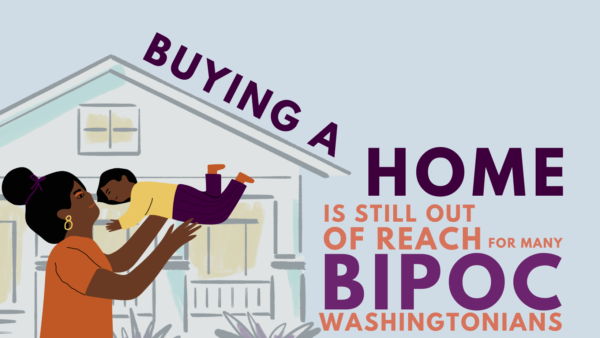
The advertised price of a home is the same for everyone. Unfortunately, due to systemically lower wages, buying a home is harder for BIPOC Washingtonians. Homes are typically far less affordable Black and Hispanic workers in Washington, creating an equity gap that is difficult to bridge.
Here’s the math. The estimated median wage of a white worker in Washington ($33.60/hour) means a median-priced home ($560,000) costs the equivalent of 8 years’ income. That same home costs a Black or Hispanic worker 10.5 or 10.6 years of income, respectively, at an estimated median wage of $25.73/hour and $25.33/hour, respectively.

Only a handful of occupations pay enough to afford buying a home
Wages vary dramatically between occupations. For the lucky (and relatively few) people in occupations where wages have kept pace with the cost of housing, home prices are still about as affordable as they were more than a decade ago. But for most occupations, buying a home is now a much bigger stretch – or completely out of reach.
At the peak of the housing bubble in 2007 (prior to the Great Recession), 392,000 jobs in 14 occupational groups paid a median wage sufficient to afford a median-priced home in Washington.* When home prices bottomed out in 2011, that was the case for more than 1 million jobs (in nearly 50 different occupational groups).
But as of 2021, just 293,000 jobs in Washington – in only four occupational groups – paid a median wage sufficient to afford a home at the state’s median price. Of Washington’s 10 largest occupations, only computer occupations pay a median wage sufficient to afford a median-priced home.
*Affordable is defined as purchasing a home equal in value to no more than 5 years’ full-time income.

This means that for BIPOC Washingtonians – who often work in some of the lowest-paying industries – buying a home just isn’t in the cards. Additionally, white households hold more generational wealth, whether in property or in actual cash savings. As a result, Black and Latine families, especially, are frequently trapped in a cycle of renting, which can reduce their overall net worth over time.Progressive policies – like baby bonds – are one way to help balance out this longstanding inequality and ensure that people are able to thrive in Washington.
More To Read
August 10, 2021
New State Programs May Ease a Short-Term Evictions Crisis, but Steep Rent Hikes Spell Trouble
State and local lawmakers must fashion new policies to reshape our housing market
November 20, 2020
We Can Invest in Us
Progressive Revenue to Advance Racial Equity


